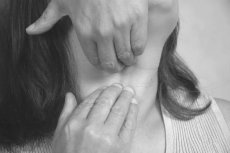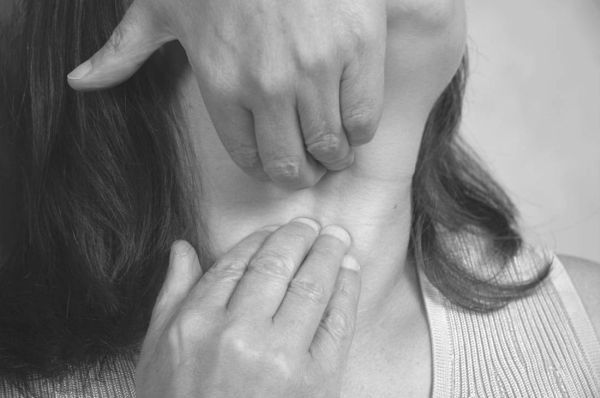Pain in an Adam's apple
Last reviewed: 23.04.2024

All iLive content is medically reviewed or fact checked to ensure as much factual accuracy as possible.
We have strict sourcing guidelines and only link to reputable media sites, academic research institutions and, whenever possible, medically peer reviewed studies. Note that the numbers in parentheses ([1], [2], etc.) are clickable links to these studies.
If you feel that any of our content is inaccurate, out-of-date, or otherwise questionable, please select it and press Ctrl + Enter.

Pain in an Adam's apple can be a symptom of many diseases, the most popular of which is thyroiditis. It is an inflammatory process that occurs in the thyroid gland and affects the condition of the entire body. What are the causes of the pain in the Adam's apple?

 [1]
[1]
What kinds of pain does it have in an Adam's apple?
Adam's apple is a protrusion that can be seen on the neck of men, which is formed by plates of the cartilage of the thyroid gland. These plates converge at an angle, because the Adam's apple protrudes on the front surface of the neck.
Subacute thyroiditis
Subacute thyroiditis is a swelling (inflammation) of the thyroid gland, which usually accompanies an infection of the upper respiratory tract.
Causes
Subacute thyroiditis is rare. It is believed that it can be caused by a viral infection. This condition often occurs after a viral infection of the upper respiratory tract, such as mumps and flu.
Subacute thyroiditis is most common in middle-aged women with symptoms of a viral respiratory tract infection.
 [2],
[2],
Symptoms
The most obvious symptom of subacute thyroiditis is pain in the Adam's apple. Sometimes pain can spread (is reflected) in the jaw or ears. Painful enlargement of the thyroid gland can continue for weeks or months.
Other symptoms of thyroiditis include:
- Difficult swallowing
- Fatigue
- Fever
- Hoarseness
- Sensitivity in the Adam's apple for palpation
- Weakness
Hyperthyroidism
Symptoms of another thyroid disease - hyperthyroidism, when too many thyroid hormones are produced:
- Diarrhea
- Heat intolerance
- Nervousness
- Palpitation
- Sweating
- Tremor
- Loss in weight
Hypothyroidism
Even with pain in an Adam's apple, hypothyroidism of the thyroid gland can be troubling. His symptoms are:
- Cold intolerance
- Constipation
- Fatigue
Usually the function of the thyroid gland returns to normal. But in some cases, hypothyroidism can be permanent.
Laboratory Tests
Laboratory tests in the early stages of the disease can show:
- Low level of thyroid-stimulating hormone (TSH) level
- High serum T4 (thyroid hormone, thyroxine)
- High serum thyroglobulin
- High rate of erythrocyte sedimentation (ESR)
- Lab tests can show on:
- High serum TSH
- Low level of free T4
Treatment
The goal of the treatment is to reduce pain and inflammation and treat hyperthyroidism. Anti-inflammatory drugs, such as aspirin or ibuprofen, are used to control pain in mild cases.
In more serious cases, it may be necessary to take temporary steroids (for example, prednisolone) to control the inflammatory process. Symptoms of hyperthyroidism are eliminated by a class of drugs called beta-blockers (eg, propranolol, atenolol).
Who should I contact if you have an apple in my Adam's apple?
Pain in an Adam's apple is a specific symptom that needs to be given maximum attention, after a thorough diagnosis. Taking care of your health is very important to exclude the development of serious diseases. Endocrinologist and therapist will help you in this.
Prospects for recovery with pain in an Adam's apple
The condition with a violation of thyroid function with pain in the Adam's apple should improve on its own. Nevertheless, the disease can last for a month. Serious complications usually do not occur.
- Possible complications
- Constant hypothyroidism
- Subacute thyroiditis may recur after treatment
- Pain in an Adam's apple can be a symptom of cervical osteochondrosis
When osteochondrosis of the cervical spine
... Compression of the vessels and nerve formations can be observed. The neck area contains many blood vessels and nerves, including the vertebral artery, which passes into the spinal canal. Therefore, if a person is diagnosed with osteochondrosis of the cervical spine with dislocation of the vertebrae, neural formations on the lateral parts of the vertebrae can cause irritation of muscles and ligaments.
And if a protrusion or a herniated disc directed to the spinal canal is attached to it (several millimeters of hernia - this is a large size of the hernia of the cervical spine), her membrane is injured and this causes swelling. Given the narrowness of the neck of the spinal canal, the edematous root fills the whole space of the canal, and this compresses this root. There is venous congestion and inflammation of the spine.
In the case of compression of the vertebral artery in connection with the narrowing of the vertebral artery (stenosis), the blood supply to the brainstem and cerebellum decreases. As a result, cervical osteochondrosis is supplemented by constant ischemia of the brain and spinal cord. An acute violation of blood flow in this area is called a dorsal stroke.
Pain in the Adam's apple can also occur when squeezing, bruising, fractures of the cartilage of the larynx
The characteristic symptoms of this condition are pain on swallowing, pain in the Adam's apple, pain when coughing, difficulty in breathing. Once a person touches the skin in the Adam's apple, it hurts. When palpation can be felt crunching cartilage, which is broken. A person in this state can be threatened with heavy breathing, like asthmatic, laryngeal edema, and emphysema.
Phlegmon cartilage of thyroid in the larynx region
In this disease, a person's fever, fever, difficulty breathing, severe pain in the Adam's apple, especially during swallowing, sometimes there is aphonia (loss of voice, transition to whisper).
Inflammation can last a long time, which causes chondroperichondritis of the larynx. In this condition, the laryngeal cartilages become inflamed, pus is formed on them, as well as fistulas.
Tuberculosis of cartilage thyroid in the larynx
This disease is often a continuation of pulmonary tuberculosis, or rather, complication. The patient may complain that he has a pershit in his throat, he feels severe pain in the Adam's apple, his voice becomes hoarse. All these symptoms depend on how far the thyroid disease has gone. Moreover, additional examinations are needed. For example, examination of sputum, the results of samples on the microbacterium tubercle bacillus. If the doctor has a suspicion of tuberculosis of the larynx, the patient should be put in a hospital and carried out the necessary studies. This can help the otolaryngologist or phthisiatrist.

